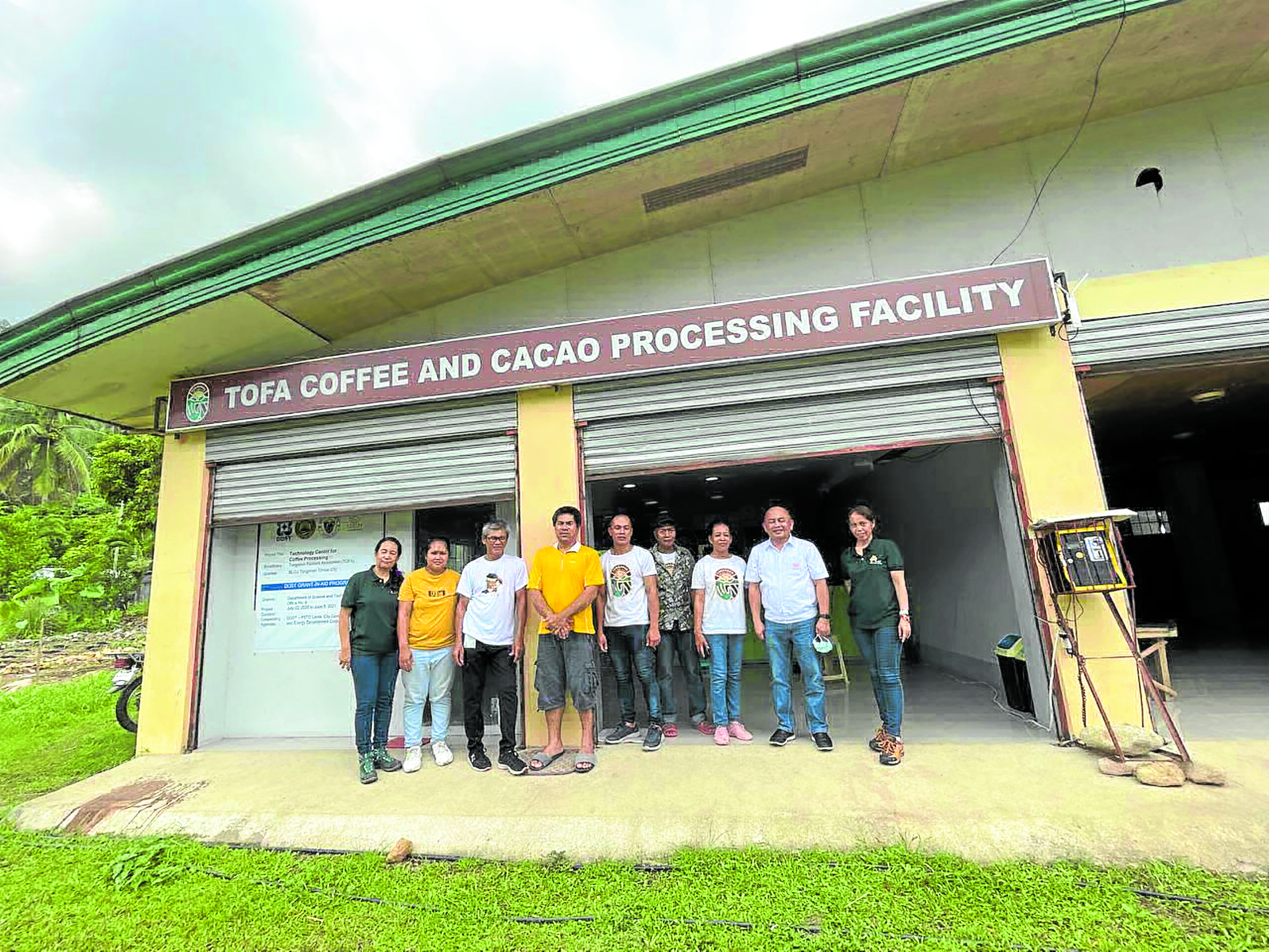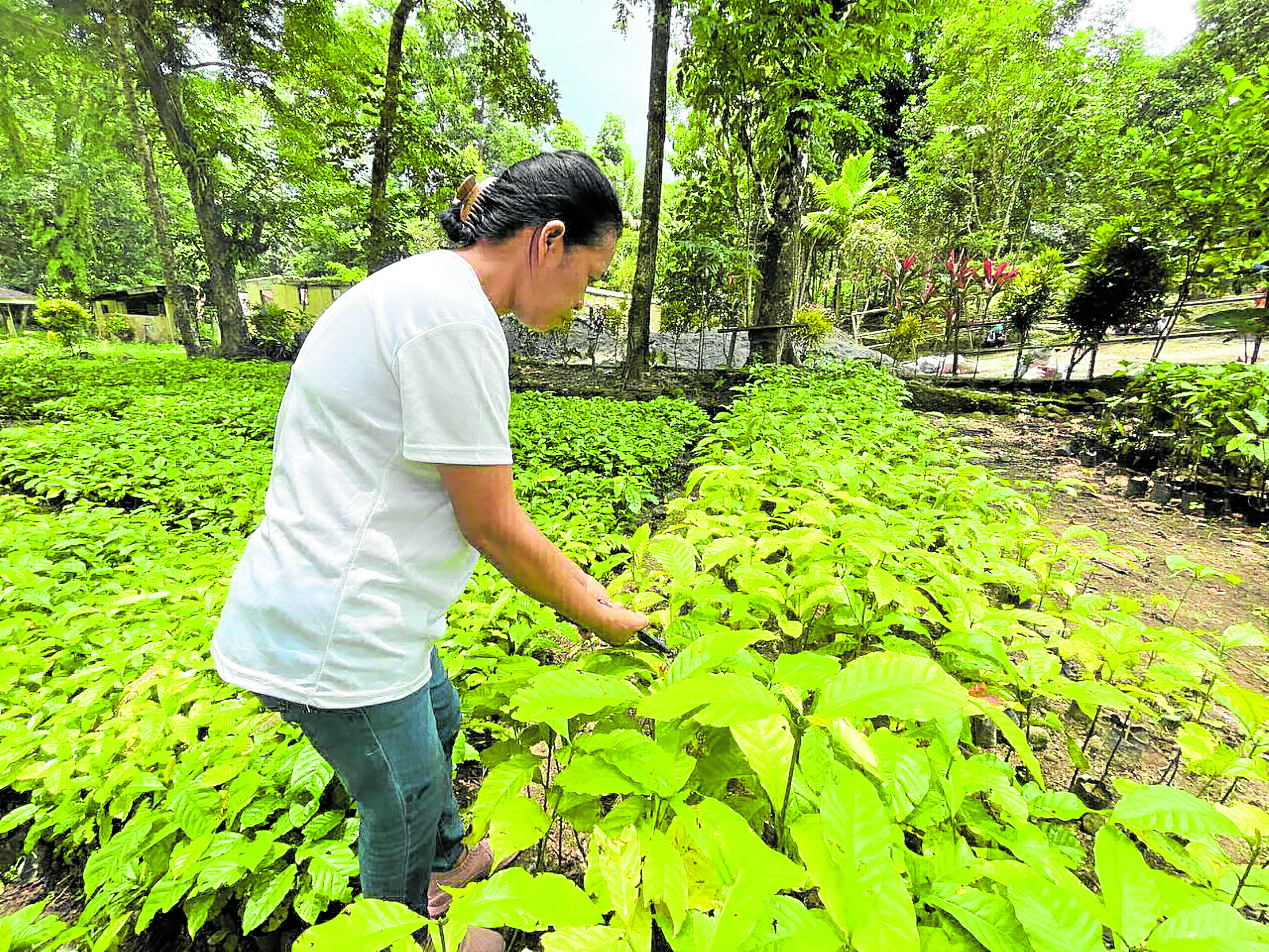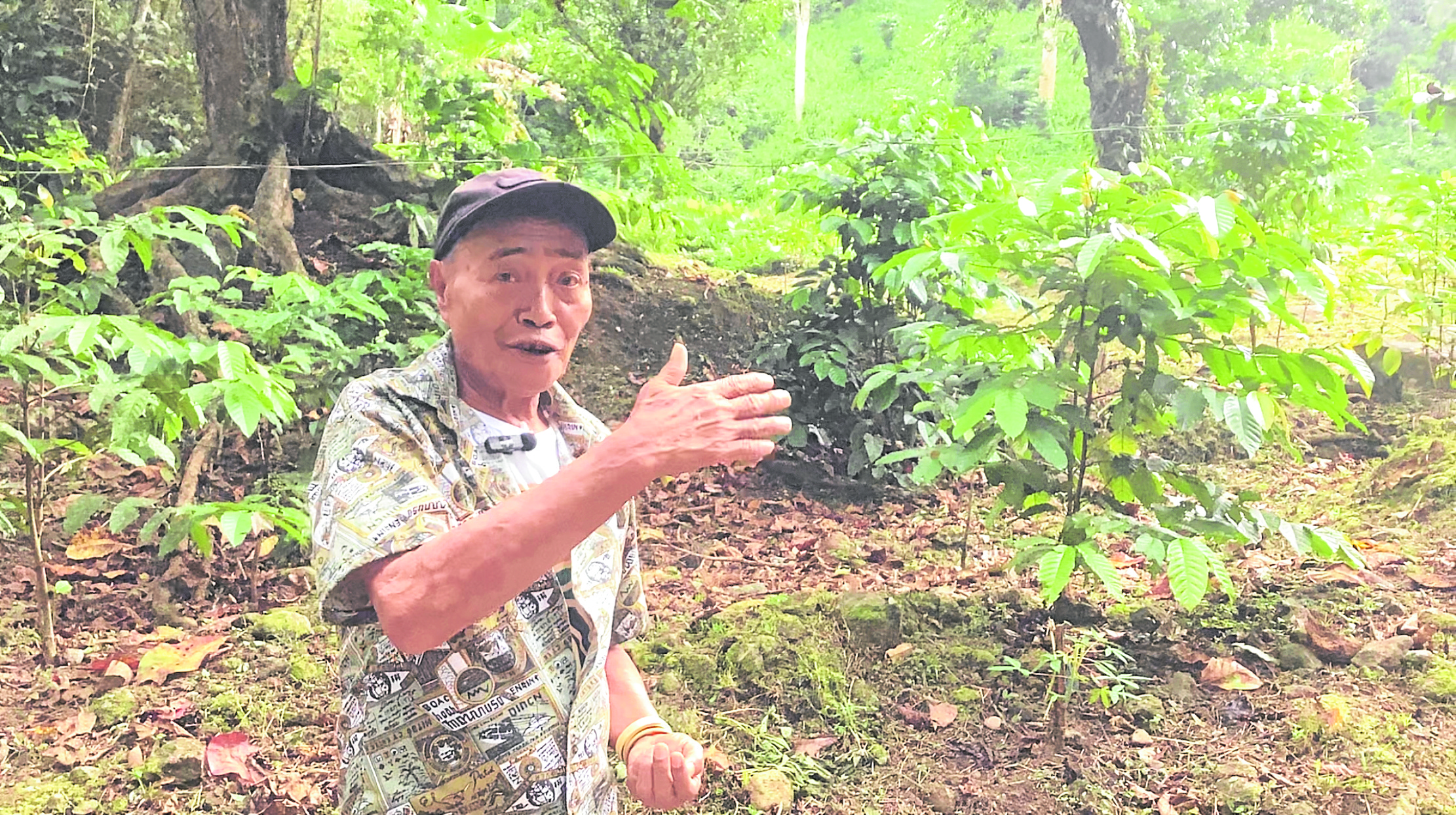Kaingin farmers turn new leaf as forest conservators

COOPERATIVE Tofa, led by president Thina Parco (third from right), was established in 1989 to encourage farmers to quit “kaingin” (slash-and-burn) farming and instead plant endangered native trees. They now grow coffee (right) deep in the mountains of Barangay Tongonan, Ormoc City, Leyte. —PHOTOS BY MEG J. ADONIS
ORMOC CITY, Leyte—Light rain was softly pattering on the roof of a makeshift nipa hut one August morning in Ormoc City when Benjamin Montera paid a brief visit to a coffee plantation deep in the mountains of Barangay Tongonan.
At 73 years old, Montera, fondly called “Tatay Ben” by close friends, has stuck to maintenance work within a 2-hectare area sprawling with coffee seedlings still too young to be harvested.
The farmer jests that his weak knees no longer allow him to freely roam around the mountains and harvest crops, but he is able to navigate the muddy, slippery slopes at their plantation with ease, as though he had been doing it for decades.
In 1989, Montera was among the more than 300 pioneer members of the Tongonan Farmers Association (Tofa) who pledged to leave behind kaingin (slash-and-burn) farming to help conserve biodiversity by planting and maintaining endangered trees endemic to the Philippines.
“We used to plant sweet potatos and cassava so we could have something to eat … And we realized the importance of participating in this kind of project because trees can protect us from natural calamities, like landslides,” Montera tells the Inquirer.
Four decades after settling in Tongonan, Montera is now the oldest and last remaining pioneer member of Tofa.
Mainstreaming native trees

As a partner community, Tofa members plant and maintain within EDC’s business area different species of trees, such as rattan as well as yakal malibato, which is endemic to the country and classified as vulnerable in the International Union for Conservation of Nature’s Red List of Threatened Species.
EDC owns and operates the 714-megawatt Leyte geothermal facility, one of the largest in the country.
But what started as an organization with more than 300 members now finds itself dwindling, with membership now down to around 90.
One of the problems, according to sustainable natural resource management specialist Rina Rosales, is that the youth often feel discouraged to follow in the footsteps of their parents due to economic disadvantages.
“Who would want to endure being a farmer under these conditions if you have the option of working [elsewhere] and earning more?” Rosales quips. “Why do we expect children of farmers and fisherfolk to continue being farmers and fisherfolk when it’s such a difficult job that doesn’t earn them much?”
On average, Filipino farmers earn P247.69 daily, 2019 data from the Philippine Statistics Authority show. Back in 1989, farmers like Montera earned only P39.09, which had a purchasing power of P5.18 in the beginning of 2023.
The daily minimum wage rate in Eastern Visayas currently ranges between P345 and P375, according to the Department of Labor and Employment. This can be used to purchase around 8 kilograms of rice, without considering other essentials such as water, electricity and food.
Better communication

STEWARD Tofa president Thina Parco sees to it that their coffee plantation is well-maintained. The plantation is one of the Tofa members’ main source of income when there are no available Binhi projects to work on.
Tofa president Thina Parco herself left Leyte in 1991 when she was just 14 years old to finish high school and work in malls.
After four years, Parco found herself back at home as her parents asked her to help out in their farm and become a Tofa member.
“I wanted to stay in Manila, but of course, I also wanted to help my parents. So I decided to go back home,” she recalls.
More than three decades later, she is now at the helm of Tofa, where she saw dozens of fellow farmers move from old nipa huts to two-story homes made of concrete as they earned higher income from the Binhi program at about P350 to P400 daily.
But Parco also saw her most beloved friends temporarily quit Tofa to work elsewhere due to a lack of available projects for members.
While the Binhi program has reached its goal of restoring 10,000 hectares of forestland, the challenge now is to find other areas to plant trees, keep the project going and provide sources of livelihood to farmers, even to the youngest generations.
“Our challenge is that we have limited area for reservation. We’re going out to different parts of the country just to look for an area to protect and conserve. If there’s land, there’s a claim. So you need to converse with communities,” says Niño Gibe, Binhi program lead.
Rosales also points out that the private sector needs to establish proper communication channels and strive to better understand the communities they want to partner with as solutions to what she calls a “mismatch of expectations.”
“There’s a lot of nuances that stop us from easily adapting to the communities, and of course their first instinct is to shy away, and they will not want to participate because there is a feeling of inadequacy,” she says.
“It’s really just a matter of finding where our objectives can converge without forcing our own agenda on them,” Rosales adds.
Data from Global Forest Watch, an online platform that provides real-time forestry data and analysis, show that Ormoc currently has around 45,100 hectares of available forestland, 43 percent of which, or about 19,400 hectares, are now covered by natural forests.
According to Erwin Magallanes, head of the EDC Leyte corporate relations unit, a vast majority of Ormoc’s available forestland already have claimants. This makes it difficult for the company to further implement the project.
Regaining numbers

FOUNDING MEMBER Benjamin Montera, 73, isBenjamin Montera, 73, is the last remainingthe last remaining pioneer of thepioneer of the Tongonan FarmersTongonan Farmers Association (Tofa).Association (Tofa
This is why Tofa members shifted their focus to maintaining a coffee and cacao processing facility that sells 250-gram bags of ground coffee beans for around P200 each.
Sales go from dozens to hundreds of bags daily, thanks to bulk orders from regular customers. Coffee is planted on the 2-hectare area in Barangay Tongonan that farmers such as Montera and Parco are maintaining.
Magallanes explains that while the company endeavors to address program gaps, starting social enterprises such as coffee plantations “helps provide livelihood while addressing the need for restoration.”
But Parco still dreams of the day when Tofa regains its strong numbers, especially now that her 21-year-old son is determined to continue the legacy of biodiversity conservation that Montera’s generation had built.
After years of observing Parco, her son now spends his summer vacations in the field.
“In the decades that we’ve worked in Tofa, we already know how important our forests are. We learned that biodiversity plays an important role in everyone’s lives,” Parco says.
“Everybody needs to participate somehow in conservation because it is a problem that is not just owned by the government. [Forest] degradation has a big impact that affects everyone,” Rosales adds.
(This story has been produced through support from USAID SIBOL, in partnership with AYEJ, under the Green Beat Plus biodiversity journalism training program. The content and publication of the report are the sole responsibility of the author and the publication.)
